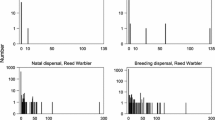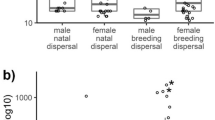Abstract
Dispersal is an important factor that determines the degree of gene flow and, hence, the degree of differentiation among populations. Using two long-term datasets on natal philopatry and short-distance dispersal in barn swallows Hirundo rustica from Denmark and Spain, we evaluated the fitness costs and benefits and test a number of predictions about the functional significance of dispersal. The proportion of philopatric individuals was more than six times larger in Spain than in Denmark, with a higher rate of philopatry in males than in females. Dispersal propensity decreased in both populations during the course of the study. Males from the more philopatric Spanish population lived longer when philopatric rather than dispersing while that was not the case for either sex of the less philopatric Danish population. There were large differences in dispersal propensity among cohorts and breeding sites, suggesting that sites differed in their suitability as sites for immigrants. We found no evidence consistent with the mate competition hypothesis suggesting that males in better condition or with larger condition-dependent secondary sexual characters were more likely to be philopatric. These findings suggest that there is a high degree of intraspecific variation in dispersal propensity between populations, probably relating to local differences in costs and benefits of philopatry and dispersal.


Similar content being viewed by others
References
Allee WC (1951) The social life of animals. Beacon Press, Boston, MA
Balbontín J, Ferrer M (2005) Factors affecting the length of the post-fledging period in the Bonelli’s Eagle Hieraaetus fasciatus. Ardea 93:189–198
Balbontín J, Hermosell IG, Marzal A, Reviriego M, de Lope F, Møller AP (2007) Age-related change in breeding performance in early life is associated with an increase in competence in the migratory barn swallow (Hirundo rustica). J Anim Ecol 76:915–925
Balbontín J, Møller AP, Hermosell IG, Marzal A, Reviriego M, de Lope F. (2009) Divergent patterns of impact of environmental conditions on life history traits in two populations of a long-distance migratory bird. Oecologia 159:859–872
Belliure J, Sorci G, Møller AP, Clobert J (2000) Dispersal distances predict subspecies richness in birds. J Evol Biol 13:480–487
Berteaux D, Boutin S (2000) Breeding dispersal in female North American red squirrels. Ecology 81:1311–1326
Berthold P (2001) Bird migration. Oxford University Press, Oxford
Brown ME (1996) Assessing body condition in birds. In: Nolan V, Ketterson ED (eds) (eds) Current Ornithology. Plenum Press, New York, pp 67–135
Clarke AL, Sæther B-E, Røskaft E (1997) Sex biased in avian dispersal: a reappraisal. Oikos 79:429–438
Clobert J, Danchin E, Dhondt AA, Nichols JD (2001) Dispersal: Individual population and community. Oxford University Press, Oxford
Clutton-Brock TH (1989) Female transfer and inbreeding avoidance in social mammals. Nature 337:70–72
Cockburn A, Scott MP, Scotts DJ (1985) Inbreeding avoidance and male-biased natal dispersal in Antechinus sp. (Marsupialia:Dasyuridae). Anim Behav 33:908–915
Cohen J (1988) Power analysis for the behavioral sciences. L Erlbaum, Hillsdale
Cramp S (ed) (1988) The Birds of the Western Palearctic, Vol 5. Oxford University Press, Oxford
Crawley JM (2002) Statistical computing. An introduction to data analysis using S-plus. Wiley, Chichester
de Lope F (1983) La avifauna de las Vegas Bajas del Guadiana. Doñana Acta Vertebrata 10:91–121
Dobson FS (1982) Competition for mates and predominant juvenile male dispersal in mammals. Anim Behav 30:1183–1192
Dobson FS, Jones WT (1985) Multiple causes of dispersal. Am Nat 126:855–858
Ellsworth EA, Belthoff JR (1999) Effects of social status on the dispersal behaviour of juvenile western screech-owls. Anim Behav 57:883–892
Favre L, Balloux F, Goudet J, Perrin N (1997) Female-biased dispersal in the monogamous mammal Crocidura russula: evidence from field data and microsatellite patterns. Proc R Soc Lond B 264:127–132
Ferrer M (1992) Natal dispersal in relation to nutritional condition in Spanish imperial eagles. Ornis Scand 23:104–106
Ferrer M (1993) Ontogeny of dispersal distances in young Spanish imperial eagles. Behav Ecol Sociobiol 32:259–263
Fretwell SD, Lucas HL (1970) On territorial behaviour and other factors influencing habitat distribution in birds theoretical development. Acta Biotheor 19:16–36
Greenwood PJ (1980) Mating systems philopatry and dispersal in birds and mammals. Anim Behav 28:1140–1162
Greenwood PJ, Harvey PH (1982) The natal and breeding dispersal of birds. Ann Rev Ecol Syst 13:1–21
Hamilton WD, May RM (1977) Dispersal in stable habitats. Nature 269:578–581
Hermosell IG, Balbontín J, Marzal A, Reviriego M, de Lope F (2007) Sex determination in barn swallows Hirundo rustica by means of discriminant analysis in two European populations. Ardeola 54:93–100
Intergovernmental Panel on Climate Change (IPCC) (2001) Third Assessment Report of the Intergovernmental Panel on Climate Change IPCC (WG I and II). Cambridge Univ Press, Cambridge
Johnson ML, Gaines MS (1990) Evolution of dispersal: Theoretical models and empirical tests using birds and mammals. Annu Rev Ecol Syst 21:449–480
Langen TA (1996) The mating system of the white-throated magpie-jay Caloccita formosa and Greenwoods hypothesis for sex-biased dispersal. Ibis 138:506–513
Mathsoft I (1999) S-plus 2000 Guide to Statistics. Data Analysis Products Division, Seattle
McCullough P, Nelder JA (1989) Generalized Linear Models. Monographs on Statistics and Applied Probability, 2nd edn. Chapman and Hall, London
Mérilä J, Kruuk LEB, Sheldon BC (2001) Natural selection on the genetical component of variance in body condition in a wild bird population. J Evol Biol 14:918–929
Møller AP (1992) Sexual Selection in the monogamous barn swallow (Hirundo rustica) Mechanisms of sexual selection. J Evol Biol 5:603–624
Møller AP (1994a) Phenotype-dependent arrival time and its consequences in a migratory bird. Behav Ecol Sociobiol 35:115–122
Møller AP (1994b) Sexual selection and the barn swallow. Oxford University Press, Oxford
Møller AP, Szép T (2002) Survival rate of adult barn swallows Hirundo rustica in relation to sexual selection and reproduction. Ecology 83:2220–2228
Møller AP, de Lope F, Saino N (1995) Sexual selection in the barn swallow Hirundo rustica VI Aerodynamic adaptations. J Evol Biol 8:671–687
Møller AP, de Lope F, Saino N (2004) Parasitism immunity and arrival date in a migratory bird the barn swallow. Ecology 85:206–219
Møller AP, Flensted-Jensen E, Mardal W (2007) Dispersal and climate change: a case study of the Arctic tern Sterna paradisaea. Global Change Biol 12:2005–2013
Moore J, Ali R (1984) Are dispersal and inbreeding avoidance related? Anim Behav 32:94–112
Nakagawa S, Cuthill IC (2007) Effect size, confidence interval and statistical significance: a practical guide for biologists. Biol Rev 82:591–605
Negro JJ, Hiraldo F, Donazar JA (1997) Causes of natal dispersal in the lesser kestrel: inbreeding avoidance or resources competition? J Anim Ecol 66:640–648
Paradis E, Baillie SR, Sutherland WJ, Gregory RD (1998) Patterns of natal and breeding dispersal in birds. J Anim Ecol 67:518–536
Pärt T (1991) Philopatry pays—a comparasion between collared flycatcher sisters. Am Nat 138:790–796
Perrin N, Lehmann L (2001) is sociality driven by the cost of dispersal or the benefits of philopatry ? A role of kin-discrimination mechanisms. Am Nat 158:471–483
Pusey AE (1987) Sex-biased dispersal and inbreeding avoidance in birds and mammals. Trends Ecol Evol 2:295–299
Pusey A, Wolf M (1996) Inbreeding avoidance in animals. Trends Ecol Evol 11:201–206
Rodenhouse NL, Sherry TW, Holmes RT (1997) Site-dependent regulation of population size: a new synthesis. Ecology 78:2025–2042
Roff DA, Mousseau T, Møller AP, de Lope F, Saino N (2004) Geographic variation in genetic architecture of morphology in wild populations of the barn swallow. Heredity 93:8–14
Rosenthal R (1994) Parametric measures of effect size. In: Cooper H, Hedges LV (eds) The Handbook of Research Synthesis. Sage, New York, pp 231–244
Schulte-Hostedde AI, Zinner B, Millar JS, Hickling GJ (2005) Restitution of mass size residuals: validating body condition indices. Ecology 86:155–163
Sutherland WJ (1996) From individual behaviour to population ecology. Oxford University Press, Oxford
Turner A (2006) The Barn Swallow. Ed. T and A D Poyser. London, U.K
Turner A, Rose C (1989) A handbook of the swallows and martins of the world. Croom Helm, London
Wolff JO (1993) What is the role of adults in mammalian juvenile dispersal? Oikos 68:173–176
Wolff JO (1994) More on juvenile dispersal in mammals. Oikos 71:349–351
Wolff JO, Plissner JH (1998) Sex biases in avian natal dispersal–an extension of the mammalian model. Oikos 83:327–330
Zar JH (1999) Biostatistical analysis. Prentice Hall, New Jersey
Acknowledgements
Thanks to all the people who helped obtain data in the field, especially F. Mateos, C. Navarro, P. Ninni, J. Cuervo, A. Barbosa, J. Moreno, S. Merino, D. Gil, L. Garamszegi, and A.N. Dreiss. This research was supported by the Spanish Ministry of Education and Science (CGL-2006-01937). JB was supported by the Spanish Ministry of Education and Science through the post-doctoral program “Juan de la Cierva”. Thank you very much to F. Stephen Dobson and to an anonymous reviewers for their constructive comments.
Author information
Authors and Affiliations
Corresponding author
Additional information
Communicated by C.R. Brown
Rights and permissions
About this article
Cite this article
Balbontín, J., Møller, A.P., Hermosell, I.G. et al. Geographic patterns of natal dispersal in barn swallows Hirundo rustica from Denmark and Spain. Behav Ecol Sociobiol 63, 1197–1205 (2009). https://doi.org/10.1007/s00265-009-0752-3
Received:
Revised:
Accepted:
Published:
Issue Date:
DOI: https://doi.org/10.1007/s00265-009-0752-3




